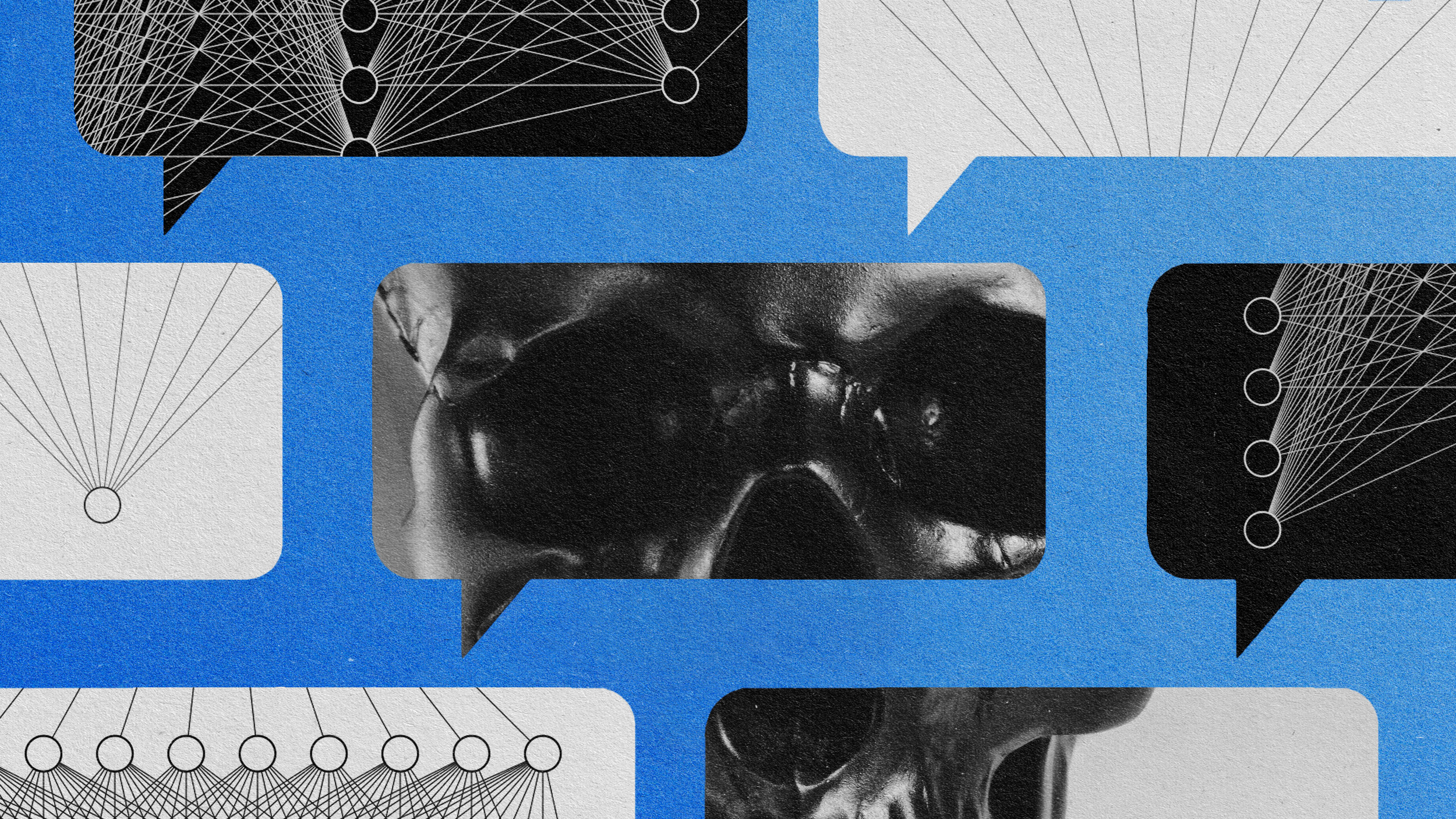Can AI create better business ideas than humans?

- Two recent studies have compared the effectiveness of ChatGPT with human brainstorming when tasked with creating new business concepts.
- Generative AI tends to produce ideas of greater potential value but less novelty.
- Currently, over-reliance on AI for business ideation — and the wider innovation process — is problematic.
A fierce debate has erupted about whether artificial intelligence (AI) can create better ideas than humans, with critical implications for the way businesses drive innovation. In a 2023 study, AI model ChatGPT came up with more and better concepts than MBA students at an elite university when asked for new consumer product ideas. “Better” was measured by “purchase intent” among a sample of target customers. The results, published in Ideas are Dimes a Dozen, show most of the “best” ideas (top 10%) also came from the AI.
However, The Crowdless Future?, another 2023 study, cast doubt on whether ChatGPT’s ideas are actually “better.” When asked for thoughts about the more complex issue of “how to unlock the potential of the circular economy,” AI produced ideas with better potential financial value, but less novelty, compared to those of humans.
The novelty factor is critical because many of the simpler problems in society have been solved. Businesses and societies need groundbreaking solutions to complex problems and firms would generally rather have one rare, brilliant idea than 10 simply “decent” ones. The authors of Ideas are Dimes a Dozen acknowledge this, but argue that if AI can generate many more ideas than humans, the chances of finding one brilliant one increase.
Leonard Boussioux, assistant professor at University of Washington, and an author of The Crowdless Future? counters that: “AI will help you make ideas more accessible, scalable, manageable and financially valuable. And it will help you correct and refine the details. But it does not yet have the capacity for groundbreaking ideas in complex areas. Humans still have an edge and a special capacity for that. That’s because AI models are based on a recombination of ideas in their training models and they provide the ‘statistically most probable’ answers, not the rarest. So our goal is to collaborate with AI to strike a balance between novelty and value.”
How AI-led ideation works
Christian Terwiesch, professor at Wharton University and an author of Ideas Are Dimes a Dozen, says: “I have no problem calling ChatGPT’s ideas original. It’s not just trawling the Internet and repeating other people’s ideas.” Instead, like a jazz musician, it’s searching for a tune or rhythm it can riff on. In his study, the AI was looking for information about the target market’s frustrations, other consumer product ideas, and other successful ventures — then mixing those to come up with fresh suggestions.
“Originality does not necessarily make it good, but the scale of data it has been trained on makes it amazingly useful,” says Terwiesch.
Like a jazz musician, ChatGPT is searching for a tune or rhythm it can riff on.
Many companies across a range of industries are already using AI tools for idea generation. For example, Ideanote, Google AI, IBM Watson, and Iris.ai all have AI-based tools to support idea generation and development. Microsoft 365 Copilot also uses prompts to generate ideas and accelerate the creative process through natural language prompts. Customers trialing Copilot worldwide, including General Motors, The Walsh Group and Avanade, have described it as “a catalyst for creativity”.

Nick Hedderman, senior director, modern work business group, at Microsoft UK, says: “The first draft probably won’t be perfect, but it’s an excellent jumpstart to human creativity.”
AI can also help you refine, expand and enhance your ideas through queries such as “provide feedback on my proposal.” And it can assist with design mockups, prototypes, consumer journeys, storyboards and pitches. That also allows businesses to explore more opportunities simultaneously and make final decisions based on better information.
A practical example is toy designer Mattel, who used Dall-e — AI that creates custom images and art from natural language descriptions — to speed their design process and make it more imaginative. Designers entered prompts like “create a scale model of a classic car.” Then they were able to refine the generated image and ask Dall-e to “transform it into a convertible,” and continue tweaking the design in collaboration with the AI however they wanted.
The pitfalls of AI-led innovation
There are many challenges to overcome when partnering with AI on end-to-end innovation. Ideation and great design, even if finessed through AI collaborations, are not enough to create a successful new product or service — you also need human judgement and selection. As Terwiesch explains: “Selection is AI’s Achilles heel. The technology can give us lots of ideas, but it cannot judge which are better.” Individual humans are generally not good at assessing the quality or potential of ideas either. But crowds are. Market research is therefore still essential to test each idea before developing it towards launch.
Terwiesch says AI’s ideation is still somewhat robotic. “You give it a prompt and it will continue to play that tune — that’s why critics have called AI a ‘stochastic parrot,’ and ‘auto-complete on steroids’,” he says. That means it’s good at using convincing language but doesn’t understand it the way humans do. Creative and innovation professionals should therefore always look to branch out and try taking the ideation and creative processes in different directions.
“Selection is AI’s Achilles heel. The technology can give us lots of ideas, but it cannot judge which are better.”
Christian Terwiesch, professor at Wharton University and co-author of Ideas Are Dimes a Dozen
AI’s lack of understanding could also lead to problems if we start relying too much on it for ideas. Boussioux says: “AI can only ideate based on its training data. If we stop relying on humans, we may lose important ideas — especially some of the more surprising, exciting, diverse or fair ones. For example, it could be harmful if we forget some important [sections of the] population in our ideation. So it also requires responsible and careful use and awareness of biases in AI and in humans.”
Boussioux says sophisticated innovation requires keeping up-to-date with AI’s “jagged frontier” — the grey area in which humans still perform better and where it can help or harm us.
Avoiding patent and copyright disputes is also a critical challenge for anyone using AI to help launch products or services. “It’s hard to know for sure there wasn’t a copyrighted concept in the training data that you’ve ended up using,” says Boussioux. “That’s a legal question I must leave to others to argue. But you should proceed carefully. One problem is we only have a small understanding of how large language models work. They can also lie and hallucinate (present false facts) but it’s hard to spot when that happens.”
Upskilling around AI will be critical to unleashing its creative potential.
AI can never be trusted blindly and always needs “parental supervision.” And businesses may need expert help explaining how important ideas were created and how to interpret them. Boussioux says evolving skills will include learning to: ask the right questions; constantly refine prompts; interrogate the concepts used in AI’s answers; and map the concepts behind it. This will help us see how those concepts are connected or not; and how similar AI-generated ideas are to existing ones. If bringing an important idea to market, you may want to build a “genealogy tree” to check these connections, which requires skilled interrogation, he says.
Hedderman says upskilling around AI will be critical to unleashing its creative potential. According to recent YouGov research, 54% of business leaders are concerned their workforce lacks the skills to maximize AI opportunities. “Also generative AI and large language models are still in their infancy,” says Hedderman. “So it’s critical to ensure AI deployment is responsible and ethical. Organizations must combat disinformation and eliminate biases, while safeguarding data privacy and respecting copyright.” He adds that Microsoft aims to mitigate the latter issue by assuming legal responsibility for any copyright disputes arising from customers using its AI products.
Boussioux urges those who design large AI models to create more transparency around the training data and how they operate. This could help businesses understand many of these problems better, including around intellectual property. Indeed, businesses will need to find ways to solve all these challenges to grasp AI’s full potential. But if they can do that and keep the innovation process legal and fair, AI can increasingly help them generate good new ideas. And, who knows, maybe a couple of brilliant ones.





